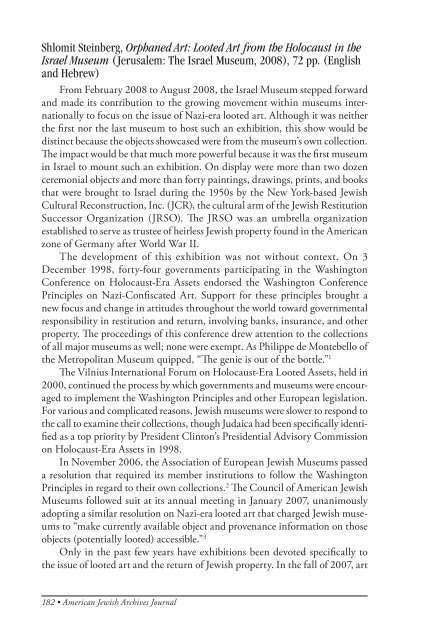The American Jewish Archives Journal, Volume LXI 2009, Number 1
The American Jewish Archives Journal, Volume LXI 2009, Number 1
The American Jewish Archives Journal, Volume LXI 2009, Number 1
Create successful ePaper yourself
Turn your PDF publications into a flip-book with our unique Google optimized e-Paper software.
Shlomit Steinberg, Orphaned Art: Looted Art from the Holocaust in the<br />
Israel Museum (Jerusalem: <strong>The</strong> Israel Museum, 2008), 72 pp. (English<br />
and Hebrew)<br />
From February 2008 to August 2008, the Israel Museum stepped forward<br />
and made its contribution to the growing movement within museums internationally<br />
to focus on the issue of Nazi-era looted art. Although it was neither<br />
the first nor the last museum to host such an exhibition, this show would be<br />
distinct because the objects showcased were from the museum’s own collection.<br />
<strong>The</strong> impact would be that much more powerful because it was the first museum<br />
in Israel to mount such an exhibition. On display were more than two dozen<br />
ceremonial objects and more than forty paintings, drawings, prints, and books<br />
that were brought to Israel during the 1950s by the New York-based <strong>Jewish</strong><br />
Cultural Reconstruction, Inc. (JCR), the cultural arm of the <strong>Jewish</strong> Restitution<br />
Successor Organization (JRSO). <strong>The</strong> JRSO was an umbrella organization<br />
established to serve as trustee of heirless <strong>Jewish</strong> property found in the <strong>American</strong><br />
zone of Germany after World War II.<br />
<strong>The</strong> development of this exhibition was not without context. On 3<br />
December 1998, forty-four governments participating in the Washington<br />
Conference on Holocaust-Era Assets endorsed the Washington Conference<br />
Principles on Nazi-Confiscated Art. Support for these principles brought a<br />
new focus and change in attitudes throughout the world toward governmental<br />
responsibility in restitution and return, involving banks, insurance, and other<br />
property. <strong>The</strong> proceedings of this conference drew attention to the collections<br />
of all major museums as well; none were exempt. As Philippe de Montebello of<br />
the Metropolitan Museum quipped, “<strong>The</strong> genie is out of the bottle.” 1<br />
<strong>The</strong> Vilnius International Forum on Holocaust-Era Looted Assets, held in<br />
2000, continued the process by which governments and museums were encouraged<br />
to implement the Washington Principles and other European legislation.<br />
For various and complicated reasons, <strong>Jewish</strong> museums were slower to respond to<br />
the call to examine their collections, though Judaica had been specifically identified<br />
as a top priority by President Clinton’s Presidential Advisory Commission<br />
on Holocaust-Era Assets in 1998.<br />
In November 2006, the Association of European <strong>Jewish</strong> Museums passed<br />
a resolution that required its member institutions to follow the Washington<br />
Principles in regard to their own collections. 2 <strong>The</strong> Council of <strong>American</strong> <strong>Jewish</strong><br />
Museums followed suit at its annual meeting in January 2007, unanimously<br />
adopting a similar resolution on Nazi-era looted art that charged <strong>Jewish</strong> museums<br />
to “make currently available object and provenance information on those<br />
objects (potentially looted) accessible.” 3<br />
Only in the past few years have exhibitions been devoted specifically to<br />
the issue of looted art and the return of <strong>Jewish</strong> property. In the fall of 2007, art<br />
182 • <strong>American</strong> <strong>Jewish</strong> <strong>Archives</strong> <strong>Journal</strong>

















